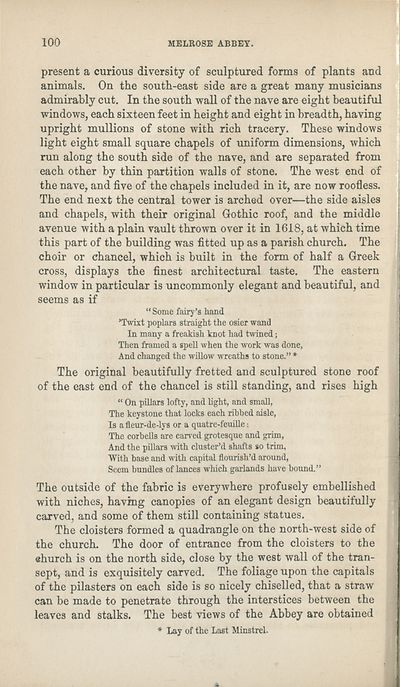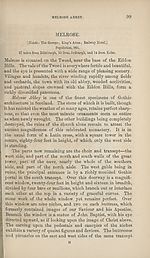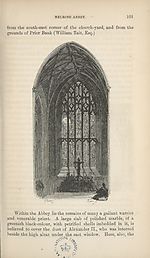Download files
Complete book:
Individual page:
Thumbnail gallery: Grid view | List view

100
MELROSE ABBEY.
present a curious diversity of sculptured forms of plants and
animals. On the south-east side are a great many musicians
admirably cut. In the south wall of the nave are eight beautiful
windows, each sixteen feet in height and eight in breadth, having
upright mullions of stone with rich tracery. These windows
light eight small square chapels of uniform dimensions, which
run along the south side of the nave, and are separated from
each other by thin partition walls of stone. The west end of
the nave, and five of the chapels included in it, are now roofless.
The end next the central tower is arched over—the side aisles
and chapels, with their original Gothic roof, and the middle
avenue with a plain vault thrown over it in 1618, at which time
this part of the building was fitted up as a parish church. The
choir or chancel, which is built in the form of half a Greek
cross, displays the finest architectural taste. The eastern
window in particular is uncommonly elegant and beautiful, and
seems as if
“ Some fairy’s hand
Twixt poplars straight the osier wand
In many a freakish knot had twined;
Then framed a spell when the work was done.
And changed the willow wreaths to stone.” *
The original beautifully fretted and sculptured stone roof
of the east end of the chancel is still standing, and rises high
“ On pillars lofty, and light, and small,
The keystone that locks each ribbed aisle,
Is afleur-de-lys or a quatre-feuille:
The corbells are carved grotesque and grim,
And the pillars with cluster’d shafts so trim,
With base and with capital flourish’d around,
Seem bundles of lances which garlands have bound.”
The outside of the fabric is everywhere profusely embellished
with niches, having canopies of an elegant design beautifully
carved, and some of them still containing statues.
The cloisters formed a quadrangle on the north-west side of
the church. The door of entrance from the cloisters to the
ehurch is on the north side, close by the west wall of the tran¬
sept, and is exquisitely carved. The foliage upon the capitals
of the pilasters on each side is so nicely chiselled, that a straw
can be made to penetrate through the interstices between the
leaves and stalks. The best views of the Abbey are obtained
* Lay of the Last Minstrel.
MELROSE ABBEY.
present a curious diversity of sculptured forms of plants and
animals. On the south-east side are a great many musicians
admirably cut. In the south wall of the nave are eight beautiful
windows, each sixteen feet in height and eight in breadth, having
upright mullions of stone with rich tracery. These windows
light eight small square chapels of uniform dimensions, which
run along the south side of the nave, and are separated from
each other by thin partition walls of stone. The west end of
the nave, and five of the chapels included in it, are now roofless.
The end next the central tower is arched over—the side aisles
and chapels, with their original Gothic roof, and the middle
avenue with a plain vault thrown over it in 1618, at which time
this part of the building was fitted up as a parish church. The
choir or chancel, which is built in the form of half a Greek
cross, displays the finest architectural taste. The eastern
window in particular is uncommonly elegant and beautiful, and
seems as if
“ Some fairy’s hand
Twixt poplars straight the osier wand
In many a freakish knot had twined;
Then framed a spell when the work was done.
And changed the willow wreaths to stone.” *
The original beautifully fretted and sculptured stone roof
of the east end of the chancel is still standing, and rises high
“ On pillars lofty, and light, and small,
The keystone that locks each ribbed aisle,
Is afleur-de-lys or a quatre-feuille:
The corbells are carved grotesque and grim,
And the pillars with cluster’d shafts so trim,
With base and with capital flourish’d around,
Seem bundles of lances which garlands have bound.”
The outside of the fabric is everywhere profusely embellished
with niches, having canopies of an elegant design beautifully
carved, and some of them still containing statues.
The cloisters formed a quadrangle on the north-west side of
the church. The door of entrance from the cloisters to the
ehurch is on the north side, close by the west wall of the tran¬
sept, and is exquisitely carved. The foliage upon the capitals
of the pilasters on each side is so nicely chiselled, that a straw
can be made to penetrate through the interstices between the
leaves and stalks. The best views of the Abbey are obtained
* Lay of the Last Minstrel.
Set display mode to:
![]() Universal Viewer |
Universal Viewer | ![]() Mirador |
Large image | Transcription
Mirador |
Large image | Transcription
| Antiquarian books of Scotland > Scotland/Scots > Black's picturesque tourist of Scotland > (160) |
|---|
| Permanent URL | https://digital.nls.uk/130030110 |
|---|
| Description | Thousands of printed books from the Antiquarian Books of Scotland collection which dates from 1641 to the 1980s. The collection consists of 14,800 books which were published in Scotland or have a Scottish connection, e.g. through the author, printer or owner. Subjects covered include sport, education, diseases, adventure, occupations, Jacobites, politics and religion. Among the 29 languages represented are English, Gaelic, Italian, French, Russian and Swedish. |
|---|

